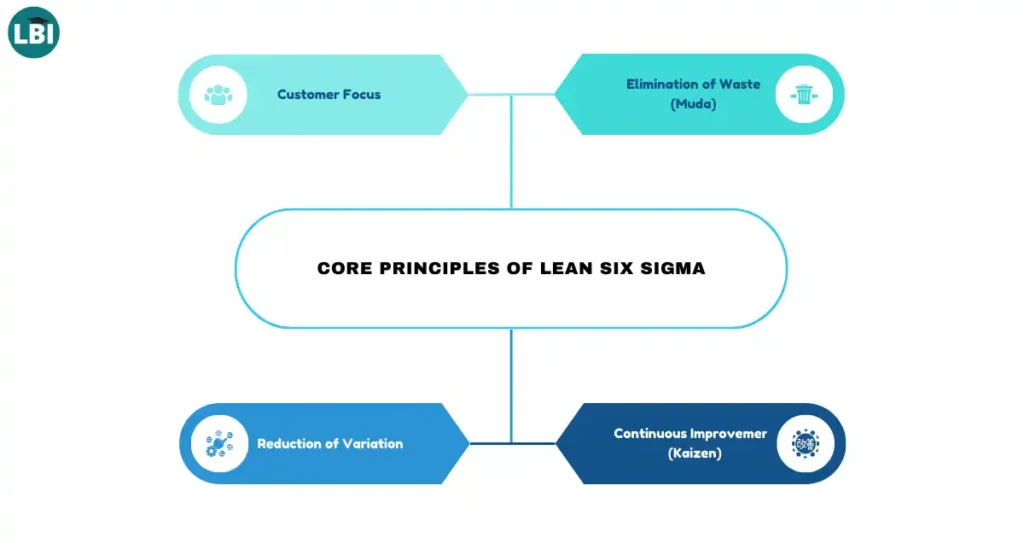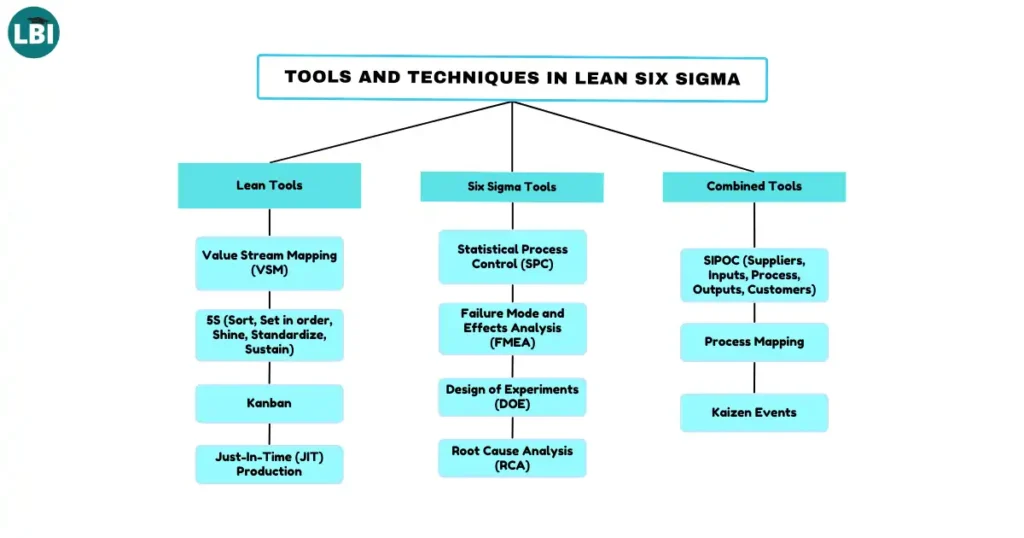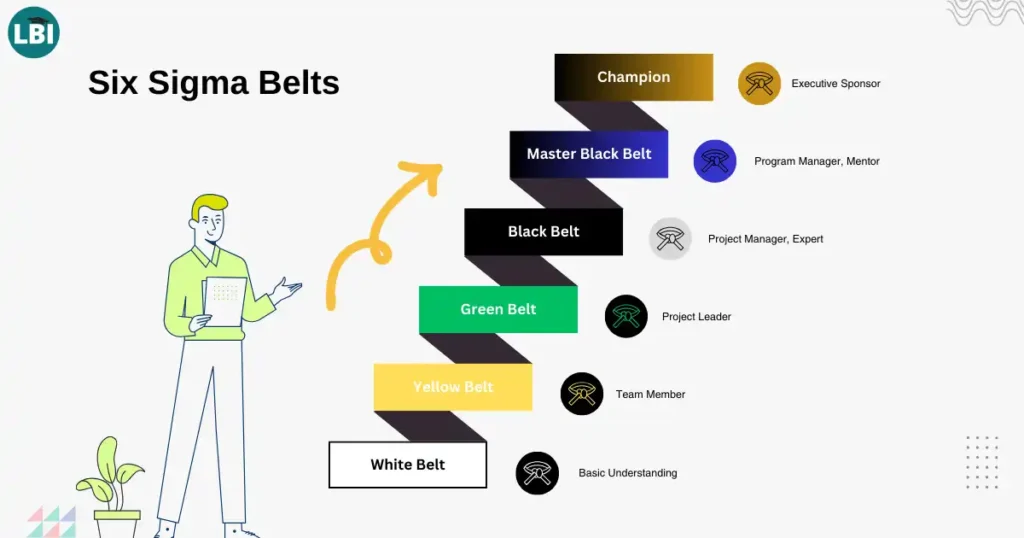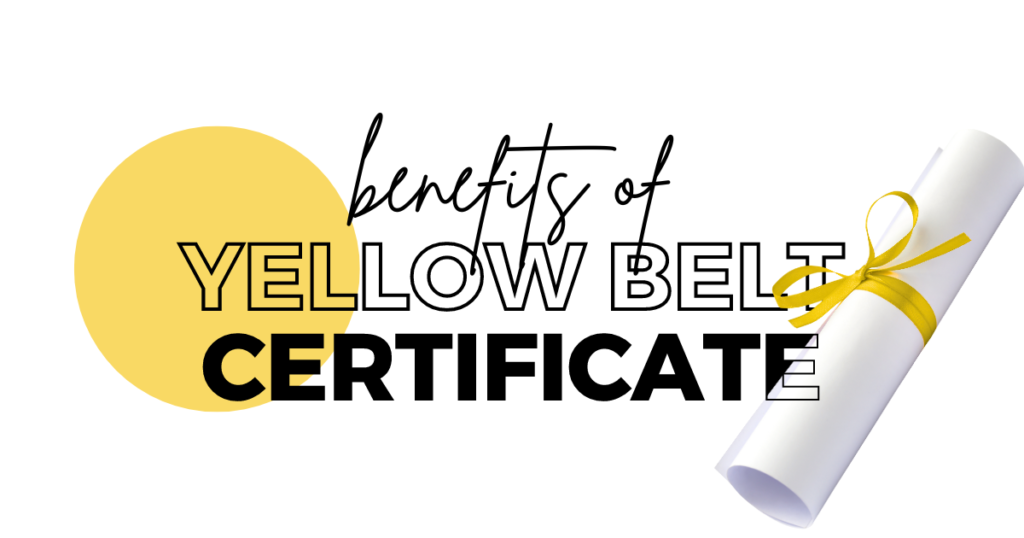Table of Contents
Introduction
Definition of Lean Six Sigma
Lean Six Sigma is a methodology that combines the principles of Lean manufacturing and Six Sigma to improve overall business performance. It aims to reduce waste, improve efficiency, and enhance product quality by focusing on customer satisfaction and data-driven decision-making.
Explanation of Lean
Lean is a systematic approach that originated from the Toyota Production System. It focuses on eliminating waste (referred to as “muda” in Japanese) within a manufacturing system. Waste can come in many forms, such as overproduction, waiting time, transportation, excess inventory, and defects. The primary goal of Lean is to create more value for customers with fewer resources.
Explanation of Six Sigma
Six Sigma, developed by Motorola in the 1980s, is a set of techniques and tools for process improvement. It seeks to identify and remove the causes of defects and variability in manufacturing and business processes. The term “Six Sigma” refers to the goal of achieving a defect rate of no more than 3.4 defects per million opportunities, which translates to a high level of process capability.
Integration of Lean and Six Sigma
The integration of Lean and Six Sigma brings together the strengths of both methodologies. Lean focuses on streamlining processes and eliminating waste, while Six Sigma provides a robust framework for reducing variation and improving quality. Together, Lean Six Sigma helps organizations achieve faster processes with higher quality and lower costs.
History and Evolution
Origins of Lean (Toyota Production System)
The concept of Lean originated from the Toyota Production System (TPS) developed by Toyota in Japan during the 1940s and 1950s. TPS was designed to increase efficiency and reduce waste in the manufacturing process. It introduced key principles such as Just-In-Time (JIT) production, Jidoka (automation with a human touch), and continuous improvement (Kaizen).
Origins of Six Sigma (Motorola)
Six Sigma was developed by Motorola in the 1980s as a way to improve quality and reduce defects in its products. The methodology was popularized by General Electric (GE) in the 1990s under the leadership of Jack Welch. It involves a structured DMAIC (Define, Measure, Analyze, Improve, Control) approach to problem-solving and process improvement.
Merger of Lean and Six Sigma Concepts
The merger of Lean and Six Sigma concepts began in the late 1990s and early 2000s, as organizations recognized the complementary nature of the two methodologies. Lean Six Sigma combines the waste-reduction focus of Lean with the quality-improvement tools of Six Sigma, resulting in a powerful approach to process optimization that can be applied across various industries.
Importance and Relevance in Modern Business
Benefits of Implementing Lean Six Sigma
Implementing Lean Six Sigma offers numerous benefits to businesses, including:
- Improved process efficiency and reduced cycle times.
- Enhanced product and service quality.
- Increased customer satisfaction and loyalty.
- Reduced operational costs and increased profitability.
- Better utilization of resources and workforce.
Industries and Sectors Where Lean Six Sigma is Applied
Lean Six Sigma is applied across a wide range of industries, including manufacturing, healthcare, finance, logistics, and service sectors. Its versatility and effectiveness in improving processes and reducing waste make it a valuable tool for any organization looking to enhance its performance and competitiveness.
Core Principles of Lean Six Sigma

Customer Focus
In Lean Six Sigma, everything starts and ends with the customer. The goal is to deliver products and services that meet or exceed customer expectations.
Voice of the Customer (VoC)
Voice of the Customer (VoC) is a process used to capture the requirements and feedback from customers. It involves various methods like surveys, interviews, and focus groups to understand customer needs and preferences. This information is crucial for guiding improvement efforts.
Critical to Quality (CTQ) Characteristics
Critical to Quality (CTQ) characteristics are the key attributes that customers consider essential for a product or service. Identifying CTQs helps businesses focus on what matters most to their customers and ensure that these attributes are consistently met or exceeded.
Elimination of Waste (Muda)
The concept of eliminating waste, or “muda,” is central to Lean methodology. Waste refers to any activity that does not add value to the customer.
Types of Waste (TIMWOOD)
Lean identifies seven types of waste, often remembered by the acronym TIMWOOD:
- Transportation: Unnecessary movement of materials or products.
- Inventory: Excess products or materials not being processed.
- Motion: Unnecessary movement of people within the process.
- Waiting: Idle time when resources are not being used.
- Overproduction: Producing more than what is needed.
- Overprocessing: Doing more work or adding more features than necessary.
- Defects: Errors that require rework or rejection.
By targeting these types of waste, organizations can streamline their processes and improve efficiency.
Also Read: The 8 Wastes of Lean: A Comprehensive Guide
Reduction of Variation
Consistency is key to producing high-quality products and services. Reducing variation ensures that processes produce predictable and reliable outcomes.
Importance of Process Consistency
Process consistency minimizes errors and defects, leading to higher quality and customer satisfaction. It also helps in maintaining a predictable production schedule and resource utilization.
Role of Statistical Analysis
Statistical analysis is a cornerstone of Six Sigma. Tools like control charts, histograms, and Pareto charts are used to identify and control variations in processes. By analyzing data, organizations can pinpoint the root causes of variation and address them effectively.
Also Read: The Essential 7 QC Tools for Effective Quality Management
Continuous Improvement (Kaizen)
Continuous improvement, or Kaizen, is about making ongoing, incremental improvements to processes.
Culture of Ongoing Improvement
A culture of continuous improvement encourages every employee to look for ways to improve their work processes. This mindset fosters innovation and helps organizations stay competitive.
Small, Incremental Changes vs. Large-Scale Transformations
Kaizen focuses on small, incremental changes rather than large-scale transformations. These small improvements accumulate over time, leading to significant enhancements in efficiency, quality, and customer satisfaction.
Methodologies of Lean Six Sigma

DMAIC Framework
The DMAIC framework is a core tool used in Lean Six Sigma for improving existing processes. It provides a structured approach to problem-solving and process improvement.
Define: Identify the problem and scope
In the Define phase, the main objective is to clearly identify the problem or opportunity for improvement. This involves:
- Defining the project goals and objectives.
- Identifying the scope of the project.
- Understanding the needs of the stakeholders.
- Creating a project charter that outlines the problem statement, project goals, scope, timeline, and team members.
Measure: Collect data and establish baselines
The Measure phase focuses on gathering data to understand the current performance of the process. Key activities include:
- Identifying key performance indicators (KPIs).
- Collecting relevant data.
- Establishing baseline measurements to quantify the problem.
- Validating the measurement system to ensure data accuracy.
Analyze: Determine root causes of issues
In the Analyze phase, the goal is to identify the root causes of the problem. This involves:
- Analyzing the collected data to uncover patterns and trends.
- Using tools like cause-and-effect diagrams (Ishikawa), Pareto charts, and regression analysis.
- Verifying the root causes through hypothesis testing.
- Prioritizing the root causes to focus on the most significant issues.
Improve: Implement and test solutions
The Improve phase is where solutions are developed and tested. Key steps include:
- Brainstorming potential solutions to address the root causes.
- Prioritizing and selecting the best solutions based on feasibility and impact.
- Developing a plan to implement the solutions.
- Conducting pilot tests to validate the effectiveness of the solutions.
- Collecting data to measure improvements.
Control: Sustain improvements over time
The Control phase ensures that the improvements are sustained over time. This involves:
- Implementing control plans to monitor the process.
- Standardizing the improved process and documenting any changes.
- Training employees on the new process.
- Using control charts to maintain process stability.
- Continuously monitoring performance and making adjustments as needed.
DMADV Framework
The DMADV framework is used for designing new processes or products. It stands for Define, Measure, Analyze, Design, and Verify.
Define: Establish project goals
In the Define phase of DMADV, the focus is on establishing clear project goals that align with customer needs and business objectives. This includes:
- Defining the scope and objectives of the project.
- Identifying key stakeholders and their requirements.
- Creating a project charter to outline the project’s purpose, scope, and team members.
Measure: Assess customer needs and specifications
The Measure phase involves understanding customer needs and translating them into specific requirements. This includes:
- Conducting Voice of the Customer (VoC) activities.
- Identifying Critical to Quality (CTQ) characteristics.
- Gathering data on customer preferences and specifications.
- Establishing performance metrics to evaluate the new process or product.
Analyze: Develop process options
In the Analyze phase, various process or product options are developed and evaluated. This involves:
- Generating potential design alternatives.
- Using tools like Failure Modes and Effects Analysis (FMEA) to assess risks.
- Evaluating the feasibility and impact of different options.
- Selecting the best design option based on data and analysis.
Design: Create detailed process design
The Design phase focuses on creating a detailed design for the new process or product. This includes:
- Developing detailed plans, drawings, and specifications.
- Using simulation and modeling tools to refine the design.
- Collaborating with cross-functional teams to ensure all aspects are considered.
- Preparing for implementation by developing a pilot or prototype.
Verify: Validate the design’s performance
In the Verify phase, the new design is tested and validated to ensure it meets the desired performance standards. This involves:
- Conducting pilot tests or simulations to validate the design.
- Collecting data to compare performance against specifications.
- Making any necessary adjustments based on test results.
- Finalizing the design and preparing for full-scale implementation.
Also Read: DMAIC and DMADV
Tools and Techniques in Lean Six Sigma

Understanding and utilizing the right tools and techniques is crucial to effectively implementing Lean Six Sigma. These tools help in identifying, analyzing, and solving problems to improve processes.
Lean Tools
Lean tools are designed to eliminate waste and enhance process efficiency. Here are some key Lean tools:
1. Value Stream Mapping (VSM)
Value Stream Mapping (VSM) is a visual tool that helps identify all the steps involved in a process and highlights areas of waste. By mapping out the current state of a process, organizations can pinpoint inefficiencies and develop an improved future state.
2. 5S (Sort, Set in order, Shine, Standardize, Sustain)
5S is a workplace organization method that helps create a clean, organized, and efficient work environment. The five steps are:
- Sort: Remove unnecessary items from the workspace.
- Set in order: Organize remaining items for easy access.
- Shine: Clean and inspect the workspace regularly.
- Standardize: Establish standards for maintaining organization.
- Sustain: Ensure ongoing adherence to the 5S principles.
3. Kanban
Kanban is a visual scheduling system that helps manage workflow and inventory. It uses cards or signals to indicate the status of work items and ensure that production matches demand, reducing overproduction and bottlenecks.
4. Just-In-Time (JIT) Production
Just-In-Time (JIT) production is a strategy that aims to produce only what is needed, when it is needed, and in the quantity needed. This approach reduces inventory costs and minimizes waste by aligning production closely with customer demand.
Six Sigma Tools
Six Sigma tools focus on reducing variation and improving quality through data-driven decision-making. Here are some essential Six Sigma tools:
1. Statistical Process Control (SPC)
Statistical Process Control (SPC) uses statistical methods to monitor and control a process. By analyzing data from process outputs, SPC helps identify variations and determine whether a process is stable and predictable.
2. Failure Mode and Effects Analysis (FMEA)
Failure Mode and Effects Analysis (FMEA) is a systematic approach for identifying potential failure modes in a process or product and assessing their impact. FMEA helps prioritize issues based on their severity, occurrence, and detectability, allowing teams to focus on the most critical risks.
3. Design of Experiments (DOE)
Design of Experiments (DOE) is a statistical method used to plan, conduct, and analyze controlled tests. DOE helps identify the factors that influence a process and determine the optimal settings to achieve desired outcomes.
4. Root Cause Analysis (RCA)
Root Cause Analysis (RCA) is a technique used to identify the underlying causes of a problem. By using tools like the 5 Whys and Fishbone (Ishikawa) diagrams, RCA helps teams uncover the root causes and develop effective solutions to prevent recurrence.
Combined Tools
Certain tools and techniques are commonly used in both Lean and Six Sigma methodologies to enhance process improvement efforts.
1. SIPOC (Suppliers, Inputs, Process, Outputs, Customers)
SIPOC is a high-level process mapping tool that provides an overview of a process from start to finish. It helps teams understand the relationship between suppliers, inputs, the process itself, outputs, and customers, ensuring all aspects are considered during improvement efforts.
2. Process Mapping
Process Mapping involves creating a detailed visual representation of the steps in a process. It helps identify inefficiencies, bottlenecks, and areas for improvement. Process maps can be used to analyze both current and future states of a process.
3. Kaizen Events
Kaizen Events are focused, short-term projects aimed at improving a specific process or area. These events involve cross-functional teams working together to identify problems, develop solutions, and implement changes rapidly. Kaizen Events promote continuous improvement and employee engagement.
Roles and Responsibilities in Lean Six Sigma
For Lean Six Sigma to be effective, it requires a structured team with clearly defined roles and responsibilities. These roles are often represented by different “belts” in Six Sigma and specific titles in Lean methodology.
Six Sigma Belts

In Six Sigma, practitioners are often classified using a belt system, similar to martial arts, to denote their level of expertise and responsibility within the project.
White Belt: Basic Understanding
White Belts have a fundamental understanding of Lean Six Sigma principles. They are typically involved in supporting projects on a part-time basis and are knowledgeable about the basic concepts and terminology.
Yellow Belt: Team Member
Yellow Belts are team members who assist with Lean Six Sigma projects. They have a deeper understanding than White Belts and participate in process improvement teams. Their role involves data collection, basic analysis, and supporting project activities.
Green Belt: Project Leader
Green Belts lead Lean Six Sigma projects and are responsible for executing improvement initiatives within their department. They have a thorough understanding of the DMAIC framework and the tools and techniques used in Lean Six Sigma. Green Belts typically work on projects part-time while maintaining their regular job responsibilities.
Black Belt: Project Manager, Expert
Black Belts are full-time project managers who lead significant Lean Six Sigma projects across the organization. They have advanced knowledge of Lean Six Sigma methodologies and are skilled in the use of statistical tools. Black Belts mentor Green Belts and other team members to ensure successful project outcomes.
Master Black Belt: Program Manager, Mentor
Master Black Belts are highly experienced Lean Six Sigma practitioners who oversee multiple projects and initiatives. They act as mentors to Black Belts and Green Belts, providing guidance and support. Master Black Belts are responsible for strategic planning, training, and ensuring the overall success of the Lean Six Sigma program within the organization.
Champion: Executive Sponsor
Champions are senior executives who sponsor Lean Six Sigma projects. They provide the necessary resources and support to ensure project success. Champions are responsible for aligning Lean Six Sigma initiatives with the organization’s strategic goals and removing any obstacles that may hinder progress.
Also Read: Help me choose a Six Sigma Belt/Level
Lean Roles
In Lean methodology, specific roles are designated to ensure the efficient implementation of Lean principles and continuous improvement efforts.
Lean Facilitator
Lean Facilitators are responsible for guiding and supporting Lean initiatives within the organization. They help teams identify waste, streamline processes, and implement Lean tools and techniques. Lean Facilitators often lead Kaizen events and provide training and coaching to team members.
Process Owner
Process Owners have accountability for specific processes within the organization. They are responsible for the performance and continuous improvement of their processes. Process Owners work closely with Lean Facilitators and Six Sigma Belts to implement changes and ensure sustained improvements.
Continuous Improvement Leader
Continuous Improvement Leaders are dedicated to fostering a culture of ongoing improvement within the organization. They lead and support various Lean and Six Sigma projects, promote best practices, and encourage employees at all levels to contribute to process enhancement. Continuous Improvement Leaders play a key role in driving the organization’s overall improvement strategy.
Implementation Strategies for Lean Six Sigma
Implementing Lean Six Sigma in an organization requires a well-structured approach. Here are the key strategies to ensure successful implementation.
Assessment and Planning
The first step in implementing Lean Six Sigma is to thoroughly assess the current state of the organization and develop a comprehensive plan.
Conducting Initial Assessments
Conducting initial assessments involves analyzing the existing processes, identifying areas of improvement, and understanding the organization’s readiness for Lean Six Sigma. This includes:
- Performing a SWOT analysis (Strengths, Weaknesses, Opportunities, Threats).
- Mapping out current processes and identifying inefficiencies.
- Gathering input from stakeholders to understand their perspectives and expectations.
Setting Realistic Goals and Objectives
Setting realistic goals and objectives is crucial for guiding the Lean Six Sigma initiatives. Goals should be specific, measurable, achievable, relevant, and time-bound (SMART). This helps ensure that the efforts are focused and aligned with the organization’s strategic priorities.
Training and Development
Proper training and development are essential to equip employees with the skills and knowledge required for Lean Six Sigma.
Importance of Proper Training
Training ensures that team members understand Lean Six Sigma principles, tools, and methodologies. It helps build a common language and approach across the organization. Training programs should be tailored to different roles, from basic awareness for all employees to advanced training for Six Sigma Belts and Lean Facilitators.
Certification Programs
Certification programs validate the proficiency of individuals in Lean Six Sigma methodologies. Common certifications include:
- Lean Six Sigma White Belt
- Lean Six Sigma Yellow Belt
- Lean Six Sigma Green Belt
- Lean Six Sigma Black Belt
- Lean Six Sigma Master Black Belt
These certifications not only enhance individual skills but also contribute to the overall capability of the organization.
Project Selection and Prioritization
Choosing the right projects is critical to the success of Lean Six Sigma implementation.
Criteria for Selecting Lean Six Sigma Projects
Projects should be selected based on their potential impact, feasibility, and alignment with organizational goals. Key criteria include:
- Customer impact: Projects that significantly improve customer satisfaction.
- Financial impact: Projects that offer substantial cost savings or revenue enhancement.
- Feasibility: Projects that can be realistically completed with available resources.
- Strategic alignment: Projects that support the organization’s long-term strategy.
Balancing Short-Term Wins and Long-Term Goals
Balancing short-term wins and long-term goals ensures sustained momentum and continuous improvement. Short-term wins provide immediate benefits and build confidence in Lean Six Sigma, while long-term goals drive strategic and transformative changes.
Change Management
Effective change management is essential to successfully implement Lean Six Sigma and sustain improvements.
Overcoming Resistance to Change
Resistance to change is a common challenge in any improvement initiative. To overcome this, organizations should:
- Communicate the benefits of Lean Six Sigma clearly and consistently.
- Involve employees in the process and seek their input.
- Address concerns and provide support throughout the transition.
Engaging and Motivating Employees
Engaging and motivating employees is key to fostering a culture of continuous improvement. This involves:
- Recognizing and rewarding contributions to Lean Six Sigma projects.
- Providing opportunities for professional growth and development.
- Encouraging collaboration and teamwork.
By focusing on these implementation strategies, organizations can effectively leverage Lean Six Sigma to enhance efficiency, reduce waste, and improve overall performance.
Case Studies and Real-World Applications

Manufacturing Sector
Lean Six Sigma has been widely adopted in the manufacturing sector to improve efficiency, reduce waste, and enhance product quality.
Case Study of a Manufacturing Company Implementing Lean Six Sigma
A leading automotive parts manufacturer faced challenges with high defect rates and production delays. By implementing Lean Six Sigma, the company focused on:
- Defining the problem: High defect rates in a key production line.
- Measuring the baseline: Collecting data on defect rates and production times.
- Analyzing the root causes: Using tools like Fishbone diagrams and Pareto charts to identify critical issues.
- Improving the process: Implementing solutions such as enhanced quality checks, better training for operators, and process standardization.
- Controlling the improvements: Using control charts and regular audits to sustain the gains.
The results were remarkable: a 30% reduction in defect rates and a 20% increase in production efficiency, leading to significant cost savings and improved customer satisfaction.
Healthcare Sector
Lean Six Sigma is increasingly being used in the healthcare sector to streamline processes and improve patient care.
Application of Lean Six Sigma in Reducing Patient Wait Times
A major hospital implemented Lean Six Sigma to address long patient wait times in its emergency department. The approach involved:
- Defining the scope: Focusing on the patient check-in to discharge process.
- Measuring current performance: Tracking average wait times and patient flow.
- Analyzing bottlenecks: Identifying delays at various stages of the process.
- Improving workflow: Making changes such as redesigning the triage process, optimizing staff schedules, and implementing electronic health records.
- Controlling the new process: Monitoring performance with dashboards and regular feedback loops.
The hospital achieved a 40% reduction in patient wait times, improved patient satisfaction scores, and more efficient use of resources.
Service Sector
Lean Six Sigma is also applicable in the service sector, where it helps improve customer service processes and overall service quality.
Improvement of Customer Service Processes Through Lean Six Sigma
A financial services company used Lean Six Sigma to enhance its customer service operations. The project focused on reducing customer complaints and improving response times.
- Defining the problem: High volume of customer complaints and slow response times.
- Measuring performance: Gathering data on complaint types and response times.
- Analyzing root causes: Using tools like the 5 Whys and SIPOC diagrams to identify issues.
- Improving processes: Implementing solutions such as better training for customer service representatives, upgrading the customer relationship management (CRM) system, and streamlining communication channels.
- Controlling improvements: Establishing key performance indicators (KPIs) and regular review meetings.
The initiative led to a 50% reduction in customer complaints and a 35% improvement in response times, significantly enhancing customer satisfaction and loyalty.
Supply Chain and Logistics
Lean Six Sigma can greatly benefit supply chain and logistics operations by enhancing efficiency and reducing costs.
Enhancing Efficiency and Reducing Costs in Supply Chain Operations
A global retail company implemented Lean Six Sigma to optimize its supply chain and logistics processes. The project aimed to reduce delivery times and lower transportation costs.
- Defining objectives: Reducing delivery times and transportation costs.
- Measuring current state: Collecting data on delivery times, inventory levels, and transportation costs.
- Analyzing inefficiencies: Identifying root causes of delays and high costs using value stream mapping and statistical analysis.
- Improving processes: Implementing changes like consolidating shipments, optimizing routes, and improving inventory management practices.
- Controlling the new processes: Monitoring performance with dashboards and continuous improvement initiatives.
The company achieved a 25% reduction in delivery times and a 15% decrease in transportation costs, resulting in better customer satisfaction and significant cost savings.
Challenges and Limitations of Lean Six Sigma
Implementing Lean Six Sigma can lead to significant improvements in efficiency and quality, but it is not without its challenges and limitations.
Common Challenges
Resistance to Change
One of the most common challenges in Lean Six Sigma implementation is resistance to change. Employees may be comfortable with existing processes and skeptical about new methodologies. This resistance can stem from fear of the unknown, perceived threats to job security, or simply a reluctance to alter established routines.
Lack of Management Support
Successful Lean Six Sigma initiatives require strong support from management. Without this support, projects may lack the necessary resources, authority, and motivation to drive change. A lack of management buy-in can lead to insufficient funding, inadequate staffing, and a general lack of prioritization, all of which can undermine the success of the initiative.
Inadequate Training
Proper training is crucial for the effective implementation of Lean Six Sigma. Inadequate training can result in misunderstandings, misuse of tools, and ineffective problem-solving. Employees need to be well-versed in Lean Six Sigma principles and techniques to contribute meaningfully to improvement efforts.
Limitations
Not a One-Size-Fits-All Solution
Lean Six Sigma is not a universal remedy for all organizational problems. It works best for processes that are repetitive and measurable. In creative or highly variable environments, the rigid structure of Lean Six Sigma may not be as effective. Additionally, the methodology may need to be adapted to fit the specific needs and culture of the organization.
Potential for Overemphasis on Metrics
While data and metrics are central to Lean Six Sigma, there is a risk of overemphasis on quantitative measures at the expense of qualitative factors. Focusing too heavily on metrics can lead to neglecting important aspects such as employee morale, customer experience, and innovation. It’s essential to balance data-driven decisions with a holistic view of the organization.
Overcoming Challenges
Strategies for Effective Communication
Effective communication is key to overcoming resistance to change and building support for Lean Six Sigma initiatives. Strategies include:
- Transparent communication: Clearly articulate the goals, benefits, and impact of Lean Six Sigma projects.
- Regular updates: Provide frequent updates on project progress and successes.
- Open dialogue: Encourage feedback and address concerns promptly.
- Storytelling: Share success stories and real-life examples to illustrate the positive impact of Lean Six Sigma.
Building a Supportive Culture
Creating a culture that supports continuous improvement and Lean Six Sigma principles is essential for long-term success. This involves:
- Leadership commitment: Ensure that leaders at all levels are committed to Lean Six Sigma and lead by example.
- Employee involvement: Engage employees in decision-making and problem-solving processes.
- Recognition and rewards: Recognize and reward contributions to Lean Six Sigma projects.
- Ongoing training: Provide continuous learning opportunities to keep skills and knowledge up to date.
By addressing these challenges and limitations, organizations can effectively leverage Lean Six Sigma to drive process improvements, enhance quality, and achieve sustainable results.
Future Trends and Developments in Lean Six Sigma

Lean Six Sigma continues to evolve, adapting to new technological advancements and global demands. Here are some key future trends and developments in Lean Six Sigma.
Integration with Digital Technologies
The integration of digital technologies is transforming the way Lean Six Sigma is implemented, making processes more efficient and data-driven.
Role of Data Analytics and AI in Lean Six Sigma
Data analytics and artificial intelligence (AI) are becoming integral to Lean Six Sigma. Advanced data analytics tools enable more precise measurement and analysis of processes, uncovering patterns and insights that were previously difficult to detect. AI can assist in predictive analytics, identifying potential issues before they occur, and optimizing processes through machine learning algorithms.
Use of IoT and Industry 4.0 Technologies
The Internet of Things (IoT) and Industry 4.0 technologies are revolutionizing Lean Six Sigma by providing real-time data and enhanced connectivity. IoT devices can collect vast amounts of data from various points in the production process, enabling more accurate monitoring and control. Industry 4.0 technologies, such as smart manufacturing and cyber-physical systems, facilitate greater automation and efficiency, further enhancing Lean Six Sigma initiatives.
Sustainability and Lean Six Sigma
As sustainability becomes a critical focus for businesses, Lean Six Sigma is being adapted to incorporate sustainable practices.
Incorporating Sustainable Practices
Lean Six Sigma can be used to identify and eliminate waste not only in terms of efficiency but also in terms of environmental impact. This involves optimizing resource utilization, reducing energy consumption, and minimizing waste production. By integrating sustainable practices, organizations can achieve both economic and environmental benefits.
Reducing Environmental Impact
Lean Six Sigma methodologies can be applied to reduce the environmental footprint of processes. For example, by streamlining supply chains and improving process efficiency, companies can lower their carbon emissions and reduce their reliance on non-renewable resources. This aligns with global sustainability goals and enhances the company’s reputation as a responsible corporate citizen.
Globalization and Lean Six Sigma
As businesses expand globally, Lean Six Sigma must be adapted to fit diverse international environments.
Adapting Lean Six Sigma for Global Operations
Global operations require Lean Six Sigma to be flexible and adaptable to different regulatory environments, market conditions, and operational challenges. This involves tailoring methodologies to meet local requirements and ensuring that improvement initiatives are relevant and effective across different regions.
Cross-Cultural Considerations
Implementing Lean Six Sigma in a global context necessitates awareness of cultural differences. Cross-cultural considerations include understanding variations in work practices, communication styles, and management approaches. By fostering a culturally sensitive approach, organizations can effectively implement Lean Six Sigma across diverse teams and geographies.
Conclusion
Lean Six Sigma remains a vital approach for organizations striving for operational excellence. Its ongoing relevance is evident in its adaptability to new technological advancements, integration with sustainable practices, and application across global operations. As businesses face increasing competition and complexity, the principles of Lean Six Sigma offer a reliable path to continuous improvement and enhanced performance.
Encouragement for continuous learning and improvement is crucial. Lean Six Sigma is not a one-time effort but a perpetual journey towards excellence. By fostering a culture of continuous improvement, organizations can navigate challenges, seize opportunities, and sustain long-term success.
FAQ
What is Lean Six Sigma, and how does it work?
Lean Six Sigma is a methodology that combines Lean manufacturing principles, which focus on waste reduction, with Six Sigma techniques aimed at reducing process variation. It works by following structured frameworks like DMAIC (Define, Measure, Analyze, Improve, Control) and DMADV (Define, Measure, Analyze, Design, Verify) to identify inefficiencies and improve processes.
Who can benefit from Lean Six Sigma?
Organizations across various sectors, including manufacturing, healthcare, finance, and service industries, can benefit from Lean Six Sigma. It helps improve process efficiency, reduce costs, enhance product quality, and increase customer satisfaction.
What are the different roles in Lean Six Sigma?
Lean Six Sigma roles are often designated by a belt system. These include White Belts (basic understanding), Yellow Belts (team members), Green Belts (project leaders), Black Belts (project managers and experts), and Master Black Belts (program managers and mentors). Additionally, there are roles like Lean Facilitators, Process Owners, and Continuous Improvement Leaders in Lean methodology.
How do I get Lean Six Sigma certified?
Lean Six Sigma certification can be obtained through various accredited organizations and training providers. Certifications range from White Belt to Master Black Belt, each requiring different levels of training, experience, and examination. Certified individuals gain skills in Lean Six Sigma principles, tools, and methodologies.
What are the common challenges in implementing Lean Six Sigma?
Common challenges include resistance to change, lack of management support, and inadequate training. Overcoming these challenges involves effective communication, building a supportive culture, and ensuring proper training and development for employees.
How does Lean Six Sigma integrate with digital technologies?
Lean Six Sigma integrates with digital technologies like data analytics, AI, IoT, and Industry 4.0 to enhance process monitoring, control, and optimization. These technologies provide real-time data and advanced insights, making Lean Six Sigma initiatives more effective and efficient.
Can Lean Six Sigma help in achieving sustainability goals?
Yes, Lean Six Sigma can incorporate sustainable practices by optimizing resource utilization, reducing waste, and minimizing environmental impact. This not only improves efficiency but also aligns with broader sustainability objectives and regulatory requirements.
How do you select Lean Six Sigma projects?
Projects are selected based on criteria such as potential customer impact, financial benefits, feasibility, and strategic alignment with organizational goals. Balancing short-term wins with long-term objectives ensures sustained momentum and continuous improvement.
What are some real-world applications of Lean Six Sigma?
Lean Six Sigma has been successfully applied in various sectors:
- Manufacturing: Reducing defect rates and improving production efficiency.
- Healthcare: Reducing patient wait times and improving care quality.
- Service Sector: Enhancing customer service processes.
- Supply Chain and Logistics: Optimizing supply chain operations and reducing costs.
What are the future trends in Lean Six Sigma?
Future trends include the integration of digital technologies (data analytics, AI, IoT), incorporating sustainability practices, and adapting Lean Six Sigma for global operations with considerations for cross-cultural differences.











